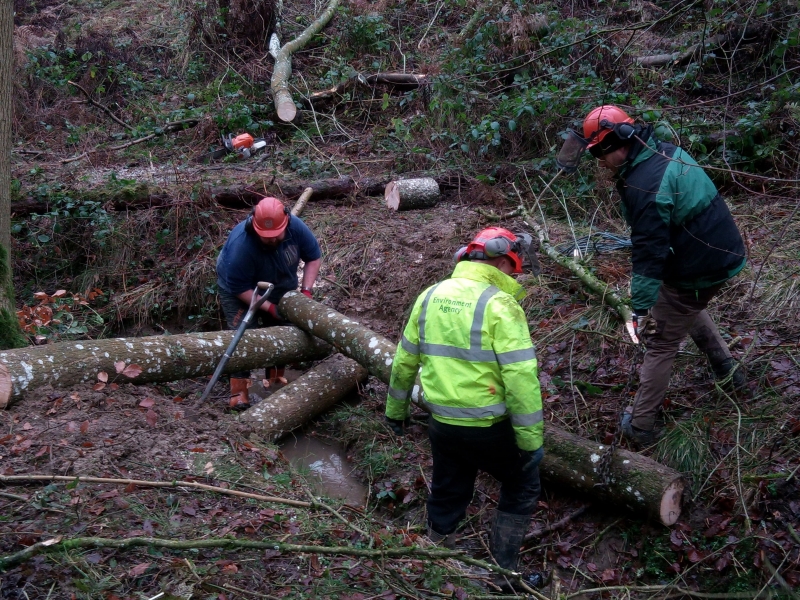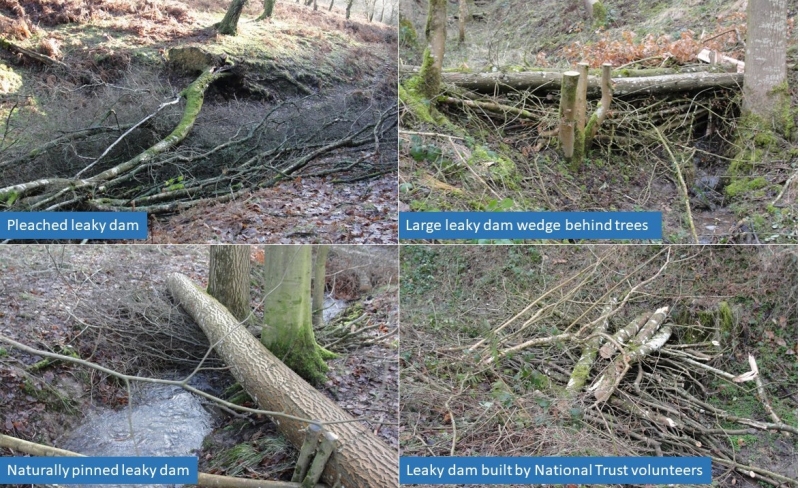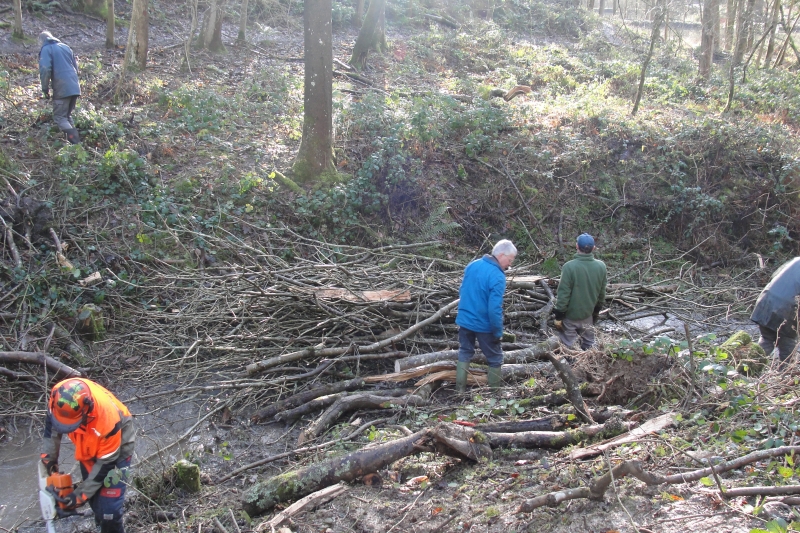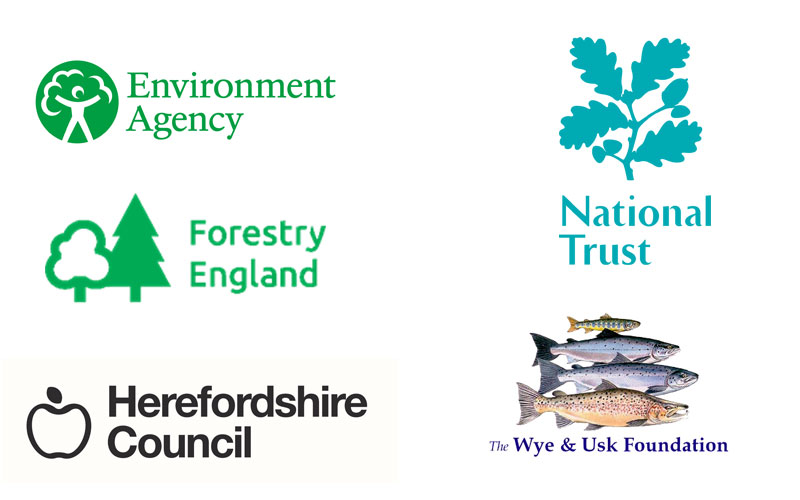Leaky dams at Croft Castle
The Herefordshire Natural Flood Management (NFM) construction grant scheme aims to reduce flood risk to local communities, as well as improve water quality and enhance biodiversity, using natural flood management processes.
The scheme runs until March 2027 and provides funding to help support landowners and farmers to alter their land and water management practices to slow the flow of water and reduce flood risk to downstream communities.
View the NFM construction grant scheme for more details and eligibility
Leaky dams project case study

Project partners working together to build leaky dams at Croft Castle.
"More NFM will be used at Croft and other properties in Herefordshire." Iain Carter, National Trust’s Countryside Manager.
What are leaky dams?
Leaky dams are built using locally sourced bankside materials such as timber to create natural dams. Leaky dams come in varying sizes and designs, and can be built using several different techniques, for example pleaching, using live trees as wedges and pinning using natural materials.
During high flow events, the leaky dams are designed to slow down the flow of water and help push flows onto the floodplain during flood events. By temporarily attenuating small volumes of water they help to reduce the flood peak and flood risk to downstream communities. Leaky dams are also designed to allow the normal flow of water to pass beneath them and where appropriate are designed to allow the safe passage of fish.
What are the benefits?
- Flood risk reduction – Leaky dams temporarily attenuate small volumes of water, helping reduce the flood peak and slow the flow of water.
- Improved water quality – Over time the leaky dams will alter sediment movements within the watercourse, providing opportunities for sediment deposition behind the structure and by creating faster flows downstream of the structure which are capable of cleaning gravels of silt.
- Habitat creation – provide a valuable habitat for wildlife.
“Dams are holding the water back and the valley is functioning much better.” “Reduced soil runoff and improved water quality.” Iain Carter, National Trust Countryside Manager

Examples of different types of leaky dam.
Site details
- Location: Croft Castle
- Water course: Ridgemoor Brook
- NFM Project Catchment area: Cheaton, Cogwell & Ridgemoor Brooks
- Ownership: National Trust, with area of land managed by Forestry England
- Designations: Fishpool Valley is a Site of Special Scientific Interest
- Protected species: White-clawed Crayfish
Story at Croft Castle
Fishpool Valley at Croft Castle and the woodland area upstream of it (Lady Wood) is the source of the Ridgemoor Brook, which during normal times is a small trickling brook. However during periods of heavy rain, large volumes of water begin to flow down the brook, over the tracks and through the valley.
In an effort to slow the flow of water, in January 2020, staff from the National Trust, Forestry England, Environment Agency, Wye and Usk Foundation and Herefordshire Council worked collaboratively to install 27 leaky dams on the Ridgemoor Brook at Croft Castle.
Starting with a training day, which was led by experienced staff at the Wye and Usk Foundation and Environment Agency, everyone developed their knowledge on the different techniques available to build and install leaky dams, for example, pleaching and pinning logs using natural materials. All staff involved were trained to use chainsaws and winches.
On the second day, using their shared experiences and skills, everyone worked collectively to build the remaining leaky dams. National Trust volunteers also helped out for the day, building the four leaky dams which are installed in Fishpool Valley SSSI.

National Trust volunteers and staff building leaky dams in Fishpool Valley.
NFM Details
What was implemented?
- 27 leaky dams
Costs
- National Trust staff and volunteers contributed their time for free
- Environment Agency staff contributed their time for free
- Remaining costs covered by the River Wye and Lugg NFM Project Construction Grant Scheme (NFM10 @ 100% contribution): £2,180
- Total cost: £2,180 (Approx. £81 per leaky dam)
Who did the work?
Collaborative project which involved staff and volunteers from the following organisations working together over a period of 2 day to implement the works:
- Wye and Usk Foundation
- National Trust (staff and volunteers)
- Forestry England
- Environment Agency (NFM advisors and operations team)
- Herefordshire Council (NFM Project Officer)
Consents
- Site of Special Scientific Interest (SSSI) Consent – Consent was required from Natural England to install the four leaky dams located within the designated SSSI Fishpool Valley area.
- Ordinary Watercourse Flood Defence Consent (FDC) – In accordance with Section 23 of the Land Drainage Act 1991, Herefordshire Council as the Lead Local Flood Authority are responsible for ensuring alterations to watercourses will not increase flood risk. FDC consent was therefore required for the 27 leaky dams installed at Croft Castle.
Interview with the landowner
Iain Carter, Countryside Manager at the National Trust gave us this useful insight into the works at Croft Castle:
How did you find out about the River Wye and Lugg NFM Project?
In a meeting with the Wye and Usk Foundation
What has the funding enabled you to do?
Build 27 leaky dams
What changes to your land have you noticed since implementing the Natural Flood Management?
Water quality has improved in the pools in Fishpool Valley with less silt feeding into the pools.Water managed better through the valley with no dams overtopping in storms.
What are the impacts to your business?
Local interest in the dams and their construction and function.
Have you observed any other benefits from the NFM work?
Certainly, reduced soil runoff and improved water quality.
Have you seen the NFM working during a heavy rainfall event, if so what did you notice?
Dams are holding the water back and the valley is functioning much better.
How have you found the experience?
Really positive partnership working with outcomes.
Will you continue to adopt Natural Flood Management practices in the future? If so which ones?
More NFM will be used at Croft and other properties in Herefordshire. I have also shared with colleagues in other Midlands National Trust portfolios.
Have you implemented any other NFM on your land which hasn’t been funded through the River Wye and Lugg NFM Construction Grant scheme? If so what have you implemented and how was it funded?
The concept is now embedded in the Ranger way of thinking and NFM techniques are frequently used.
Any tips or advice?
To all land managers - lots of small interventions can make a big difference.
Herefordshire Council would like to thank all involved for their support with implementing NFM at Croft Castle. This work forms part of the Defra funded River Wye and Lugg Natural Flood Management Project.

